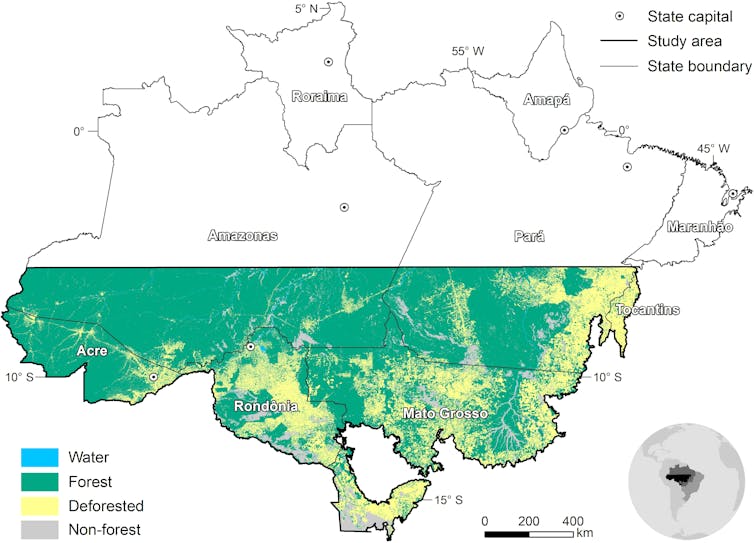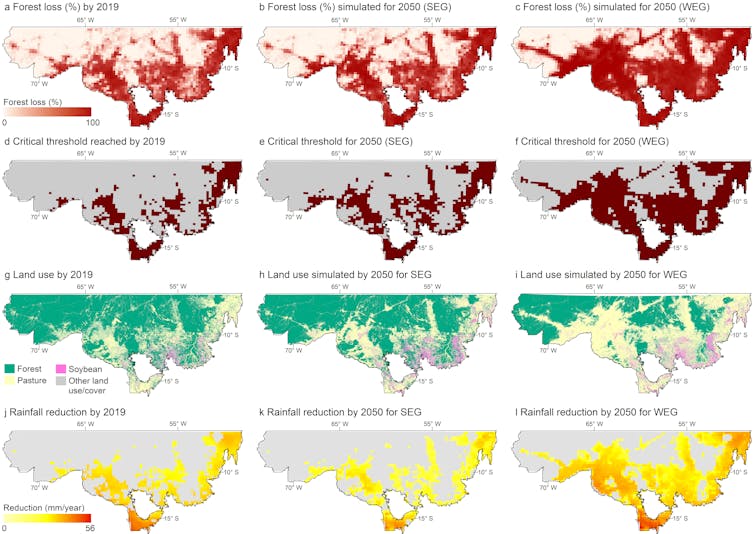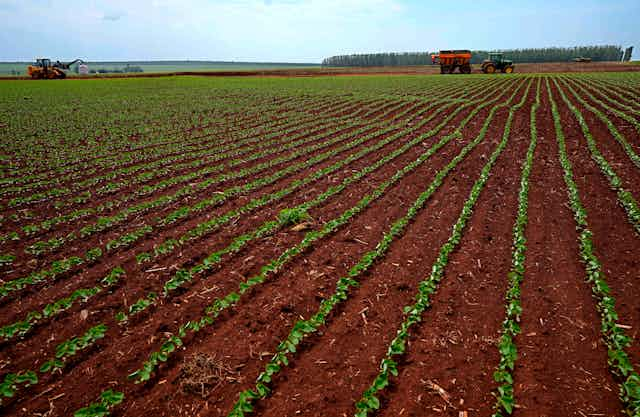The current drought situation in the Amazon, which has taken on a new level of severity this year, is influenced by two exceptional climatic conditions: the abnormally high temperature of the North Atlantic waters and the presence of the El Niño phenomenon. Despite these remarkable climatic conditions, however, the human footprint of this environmental tragedy is also visible.
The rapid progression of this drought and its intensity highlight the need for urgent response actions and support measures to tackle this crisis. In this sense, the protection of the Amazon rainforest is not only vital for biodiversity and the well-being of local communities, but also plays a key role in the stability of the local and regional climate, as well as the survival of agribusiness and global food security.
The part of agribusiness that supports an anti-environmental agenda is testing the capacity and limits of nature itself and could end up being directly affected by transformations that impact agriculture and food security not only in Brazil, but around the world.
Extensive research in the Amazon and Cerrado, the vast savanna region of eastern Brazil, has shed light on the intricate interactions between deforestation, climate change and the local, regional and global economies. The studies that our group of researchers from the Federal University of Minas Gerais (UFMG) and the University of Bonn in Germany have carried out show that the current trajectory of deforestation is diminishing the capacity of the Amazon and Cerrado to regulate rainfall patterns, putting the country’s agricultural systems – much of which is rain-fed agriculture – at great risk.
Scarcity of natural resources
The rain generated by the Amazon rainforest, on which agribusiness depends, is becoming increasingly scarce. Widespread forest loss results in hydrological and consequently economic losses. And these effects are already a reality: in 2019, a quarter of the southern Brazilian Amazon already reached the critical limit of forest loss. In some regions, the reduction in rainfall due to deforestation is already jeopardising 48% of the total volume recorded for the year.
These most affected areas are, worryingly, large soya producing regions or those where agriculture is likely to expand in the future, such as the north-eastern and south-eastern regions of the state of Pará, the west of the state of Maranhão, the central part of Rondônia and, above all, the soya belt in northern Mato Grosso. And if deforestation continues at the same pace, the losses will be enormous. Our study estimates that they could reach R$5.7 billion (US$1.16bn) per year.

In short, our studies have highlighted that deforestation not only affects the global climate, but also has significant impacts at regional and local levels. The removal of forests results in higher temperatures, leading to more frequent and intense heatwaves, which directly harms the health of local communities and agriculture, which is highly sensitive to climate change.
In addition, deforestation can trigger climate feedbacks that amplify climate change, such as decreased evapotranspiration due to vegetation loss, which can further reduce precipitation and create a cycle of drought and deforestation.
Analysing the rainy seasons
Our research in the area began in 2019, when our team conducted a detailed analysis of rainy season data in the Amazon, using information from 112 rain gauges distributed across the south of the region. Complementing this analysis, we employed annual data sets on land use, covering the period from 1974 to 2012. The results of this study were enlightening: for every 1 per cent increase in deforestation, there was a delay in the start of the rainy season of between 0.12 and 0.17 days.
In addition, we have clearly demonstrated that the probability of early onset of the rainy season decreases as the fraction of local deforestation increases. These findings have deepened our understanding of the direct implications of deforestation on climate stability in the region, providing valuable information to guide public policy.
Exceeding critical deforestation limits
The research then expanded to explore the critical limits of deforestation in the southern region of the Brazilian Amazon. We broadened the study area and investigated the relationship between historical deforestation and rainfall patterns at different geographical scales. The studies, carried out in 2021, also assessed the impacts of different deforestation policy scenarios on local agriculture.
The results of these studies were equally impressive: the loss of forest in up to 55-60% of the 28-kilometre grid areas led to an increase in rainfall, but exceeding this threshold resulted in a drastic and irreversible reduction in rainfall. This finding emphasised the complexity of the interactions between deforestation and climate, also with significant implications for the environment and the local economy.
The challenge of the Cerrado
Over the last two years, our team has also turned its attention to the Cerrado. The expansion of large-scale agriculture has transformed this biome into an important agricultural hub, contributing 63% of Brazil’s grain production and 20% of global soya production. Worryingly, this unbridled expansion in the Cerrado is on the rise, with an alarming 17% increase in deforestation rates by 2023.
In this context, we looked at what has been happening to the climate of the Cerrado, which we identified as having experienced, on average, a delay of 1 month and 26 days in the start of the agricultural rainy season, a 16 per cent reduction in the volume of rainfall and a 2°C increase in the maximum temperature since the 1980s.
How to limited rainfall reduction by 2050
It is undeniable that extraordinary climatic factors play a significant role in the current severe drought in the Amazon, especially in the state of Amazonas. The current scenario is aggravated by the convergence of two remarkable climatic conditions. Firstly, the temperature of the North Atlantic waters is abnormally high. This has a direct effect on atmospheric circulation in the region and can affect rainfall patterns.
Secondly, the presence of the El Niño phenomenon, known for its impact on the entire global climate system, is being observed. These combined factors have resulted in the drought establishing itself much more quickly and intensely than normal. This unique combination of climatic events is generating exceptional challenges for communities and local authorities, since water resources, which are essential for life in the Amazon region, are at historically low levels.
Added to these natural conditions is human action. As trees are cut down, the forest’s ability to carry out evapotranspiration and release moisture into the atmosphere is reduced, affecting cloud formation and, consequently, the occurrence of rainfall. In addition, changes in wind patterns and atmospheric currents, influenced by the presence of the forest, are hampered by deforestation, making it difficult to transport moisture to other parts of Brazil. This results in a decrease in precipitation, intensifying prolonged droughts and affecting water availability.
The extensive research that has been carried out by various researchers in the Amazon region and the Cerrado biome, both of which are of vital importance to Brazil, emphasises the need to preserve these areas for the well-being of the planet. This research goes beyond the academic sphere and is recognised internationally, having been incorporated into FAO reports and highlighted in the Intergovernmental Panel on Climate Change IPCC AR6 report.
They are relevant in formulating global environmental policies, and also play a crucial role in drawing up policies for forest conservation, reducing greenhouse gas emissions and promoting biodiversity in both biomes. They provide a solid base of scientific data on which to base decision-making and conservation strategies at regional and global levels, directly impacting on the preservation of the environment and the planning of policies for a more sustainable future, not just for Brazil, but for the whole world.
And if, on the one hand, they show a worrying scenario, on the other they point out that there is light at the end of the tunnel: we estimate that the effective application of conservation policies, including the full implementation of the Forest Code and additional incentives for conservation, could reduce by 24 per cent the total area that would reach the critical limit of rainfall reduction by 2050.

The message is clear: Brazil needs to return to the path of integrating sustainable agricultural production and conservation in the Amazon. This path includes conserving natural areas, adopting low-impact agricultural practices and investing in more efficient and environmentally friendly agricultural technologies. In addition, it is essential to recognise that excessive deforestation damages the international image of the Brazilian agricultural sector, leading many countries and companies to commit to environmental protection and to be reluctant to do business with sectors that contribute to environmental destruction.
Therefore, the preservation of Brazilian biomes is fundamental not only for environmental preservation, but also for the survival of agribusiness and global food security. Not investing in environmental conservation strategies is an anti-agribusiness attitude. Without the forest, there is no rainfall, and if there is no rainfall, there are losses. And the bill has already arrived for agribusiness.


